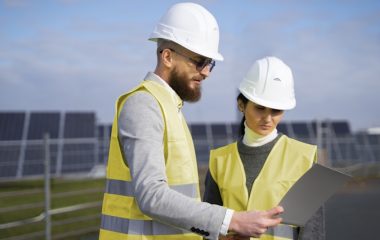
Photo: Energize d.o.o.
Share
Private investors are developing renewable energy power plants with a total capacity of around 14 GW to 15 GW in Serbia. State-owned power utility Elektroprivreda Srbije (EPS) adopted a development plan for its green energy portfolio, while prosumers, both households and businesses, who are developing solar power plants for their own consumption, are the third cornerstone of the country’s RES development, Editor of Balkan Green Energy News Branislava Jovičić said for the national broadcaster RTS.
The progress in using renewable energy sources is evident, according to a new report from the United Nations Economic Commission for Europe (UNECE). Out of 17 countries in the Balkans, Caucasus, Eastern Europe and Central Asia, Serbia shares fourth place in the list with Georgia and the increase in renewable energy capacity showed a significant drop compared to the first three countries, Serbia’s public broadcaster RTS reported.
According to the draft of the Integrated National Energy and Climate Plan or NECP, which is scheduled to enter public consultation on October 1, Serbia should get 40% of its energy from renewables in 2030 or 13 percentage points more than today.
“There are three cornerstones of renewable energy development in Serbia. The first one relates to initiatives of private investors, mostly in wind and solar power plants. Currently, around 14 GW to 15 GW of renewable energy power plants are under development in Serbia,” Editor of Balkan Green Energy News Branislava Jovičić said.
The second area, she says, is the activities of state-controlled power utility Elektroprivreda Srbije (EPS). The company presented its development plan for the green portfolio after many years of not investing in production facilities. EPS focuses on wind and solar power plants on former open-pit coal mines.
The third key segment is the prosumers segment – citizens and companies are installing solar power systems for their own consumption, Branislava Jovičić explained.
Stagnation after brief wind park construction boom
Roofs in Serbia have great potential. Their surface exceeds 600 square kilometers. If only 10% is covered with solar panels, enough electricity would be produced for six million households. More energy security alongside cleaner air.
Roofs in Serbia have a surface of more than 600 square kilometers
More than two thirds of total electricity produced in Serbia comes from fuels that pollute the environment and heat up the planet. After nine wind parks were built in the second half of the previous decade, there is no significant progress in the switch to clean energy. It slowed the country’s activities in tackling the climate crisis and its contribution to achieving the goals from the Paris Agreement.
Serbia has nine wind parks in operation
The expansion of wind power capacity and other renewables has stagnated since 2019, says Goran Vreljanski from the World Wide Fund for Nature (WWF). Ahead of the United Nations Climate Change Conference (COP27), the message is clear to investors and countries in the region that the capacities for using renewable energy sources must be increased and that efforts to adopt and implement policies in the area must be accelerated, he said.
Economic progress with a decrease in pollution is possible
Serbia has a more considerable solar potential than Germany, Poland and the Czech Republic, but the three countries produce much more energy from the sun, and they see it as cost effective.
“One of the basic ways we measure the transformation toward green energy is not only the percentage of energy produced from renewable sources but also the so-called decoupling. It is a situation when a country’s gross domestic product keeps rising year after year, and at the same time, you emit less and less carbon dioxide, in other words, you have less and less pollution,” said Professor Vladimir Đurđević from the Faculty of Physics at the University of Belgrade.
He added that it is happening not only in the most developed countries but also in the less developed ones, with economies similar to that of Serbia. “We can expect something like that to happen here as well, but it takes concrete planning,” Đurđević pointed out.









Be the first one to comment on this article.